Extract from The Guardian
On New Year’s Day 1923 a white woman was beaten
and residents of Sumner, Florida, claimed her assailant was black –
which sparked race riots where the casualties were mostly black and
hate wiped out a prosperous town
The ruins of the
two-story shanty near Rosewood, Florida, in 1923 where black
residents barricaded themselves and fought off a band of whites.
Photograph: Bettmann/Corbis
Jessica
Glenza in Cedar Key, Florida
Monday 4 January 2016 00.00 AEDT
Four black schoolchildren raced home along a dirt
road in Archer, Florida,
in 1944, kicking up a dust cloud wake as they ran. They were under
strict orders from their mother to run – not lollygag or walk or
jog, but run – directly home after hitting the road’s curve.
The littlest, six-year-old Lizzie Robinson (now
Jenkins), led the pack with a brother on each side and her sister
behind carrying her books.
“And I would be [running], my feet barely
touching the ground,” Jenkins, now 77, said at her home in Archer.
Despite strict adherence to their mother’s
orders, the siblings weren’t told why they should race home. To the
children, it was one of several mysterious dictates issued during
childhood in the Jim Crow south.
As Jenkins tells it, the children didn’t know
why Amos ’n’ Andy was often interrupted by revving engines and
calls from her father to “Go upstairs now!”, or why aunt Mahulda
Carrier, a schoolteacher, fled to the bedroom each time a car drove
down their rural road.
Explanations for demands to hide came later, when
Jenkins’s mother, Theresa Brown Robinson, whispered to her daughter
the story of violence that befell the settlement of Rosewood in 1923.
The town was 37 miles south-east of Archer on the
main road to the Gulf. Carrier worked there as the schoolteacher,
while living with her husband Aaron Carrier. On New Year’s Day
1923, a white woman told her husband “a nigger” assaulted her, a
false claim that precipitated a week of mob violence that wiped the
prosperous black hamlet off the map, and led to the near lynching of
Aaron Carrier.
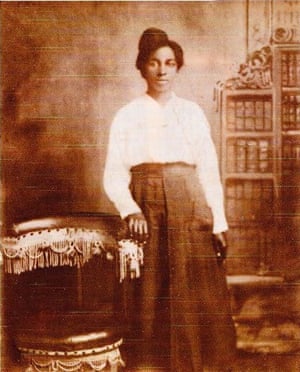
Mahulda Carrier, a schoolteacher, fled to the
bedroom each time a car drove down their rural road. Photograph:
Lizzie Jenkins
Jenkins now believes that all of it – the
running, calls to go upstairs, her aunt fleeing to the bedroom –
was a reaction to a message her parents received loud and clear:
don’t talk about Rosewood, ever, to anyone.
But after Jim Crow laws lifted, and lynch mob
justice was no longer a mortal threat, survivors did begin to talk.
So egregious were the stories of rape, murder, looting, arson and
neglect by elected officials, that Florida investigated the claims in
a 1993 report.
That led to a law that eventually compensated then
elderly victims $150,000 each, and created a scholarship fund. The
law, which provided $2.1m total for the survivors, improbably made
Florida one of the only states to create a reparations program for
the survivors of racialized violence, placing it among federal
programs that provided payments to Holocaust survivors and interned
Japanese Americans.
News of Florida’s reparations program ran
nationwide when it was passed in 1994, on the front page of the Wall
Street Journal among others. Hollywood picked up the tale. Don
Cheadle starred in a 1997 film about the pogrom. Several books were
written about Rosewood.
Though the legislation was never called such, the
program now represents one of just a handful of reparations cases in
the United States, as calls to compensate victims of racialized
violence have grown louder in the last two years.
2015 brought renewed calls to compensate victims
of race-related violence from college students, theologians and
criminal justice advocates. The city of Chicago started a $5.5m
reparations fund for the more than 100 victims tortured at the
hands of police commander Jon Burge.
Last month, students at Georgetown University
demanded that the administration set
aside an endowment to recruit black professors equal to the
profit from an 1838 slave sale that paid off university debt. The 272
slaves were sold for $400 each, the equivalent of about $2.7m today.
One day after protests began, students successfully renamed a
residence hall named after Thomas Mulledy, the university president
who oversaw the sale (it was renamed Freedom Hall).
At least one progressive Christian theologian is
pushing
Protestants to reckon their own history with slavery with
reparations. In 2014, Atlantic writer Ta-Nehisi Coates breathed fresh
life into the debate in his widely lauded article The
Case for Reparations.
Rosewood burning
Where Rosewood once stood is now little more than
a rural scrubland along state road 24, a lonely highway in central
Florida bordered by swamp, slash pine and palmetto. A placard on the
side of the road describes the horror visited upon the hamlet.
But in 1923, the settlement was a small and
prosperous predominantly black town, with its own baseball team, a
masonic temple and a few hundred residents. It was just three miles
from the predominantly white town of Sumner, and 48 miles from
Gainesville.
A black resident’s home is shown in flames
during the race riots in 1923. Photograph: Bettmann/Corbis
On New Year’s Day 1923, white Sumner resident
Fannie Taylor was bruised and beaten when her husband returned home.
The Taylors were white, and the residents of Sumner were in near
universal agreement that Fannie’s assailant was black.
A crowd swelled in Sumner to find the “fugitive”,
some from as far away as Gainesville, where the same day the Klu Klux
Klan held a high-profile parade. Over the next seven days gangs of
hundreds delivered lynch mob justice to the once-affluent town of
Rosewood.
“I blame the deputy sheriff,” Robie Mortin, a
Rosewood survivor, told the Seminole
Tribune in 1999. “Because that lady never dropped a name as to
who did what to her. Just said a negro, black man. But when the
sheriff came along with his posse and everything, he put a name to
the person: Jesse Hunter.”
Mortin died in 2010 at age
94 in Riviera Beach, Florida. She was believed to be one of the
last survivors of the New Year’s riots in 1923. After years of
silence she became one of the most vocal. Though Florida completed an
investigation into the events that took place in Rosewood, some
narratives remain disputed.
“They didn’t find Jesse Hunter, but noticed
that here’s a bunch of niggers living better than us white folks.
That disturbed these people,” Mortin said. Her uncle, Sam Carter,
is believed to have taken the man who beat Taylor, a fellow Mason, to
safety in Gulf Hammock, a few miles away. When Carter returned he was
tortured, shot and lynched by the mob looking for Taylor’s
assailant.
“My grandma didn’t know what my uncle Sammy
had done to anybody to cause him to be lynched like that,” Mortin
told the Tribune. “They took his fingers and his ears, and they
just cut souvenirs away from him. That was the type of people they
were.”
Carter is believed to be the first of eight
documented deaths associated with the riots that would worsen over
the next three days.
The Levy County sheriff, Bob Walker, holds a
shotgun allegedly used by Sylvester Carrier, black resident of
Rosewood, to shoot and kill two deputized white men who were at his
door in 1923. Photograph: Bettmann/Corbis
The settlement itself was wiped off the map.
Several buildings were set on fire just a few days after New Year’s,
and the mob wiped out the remainder of the town a few days later,
torching 12 houses one by one. At the time, the Gainesvile Sun
reported a crowd of up to 150 people watched the dozen homes and a
church set ablaze. Even the dogs were burned.
“The burning of the houses was carried out
deliberately and although the crowd was present all the time, no one
could be found who would say he saw the houses fired,” a Sun report
said, describing the scene.
At least two white men died, including CP “Poly”
Wilkerson of Sumner and Henry Andrews of Otter Creek, when they
attempted to storm a house Rosewood residents had barricaded
themselves in.
A state report on the violence
identifies murdered black Rosewood residents as Sam Carter, matriarch
Sarah Carrier, James Carrier, Sylvester Carrier and Lexie Gordon.
Mingo Williams, a black man who lived nearby, was also killed by the
mob.
Aaron Carrier, Mahulda’s husband and Jenkins’s
uncle, was nearly killed when he was dragged behind a truck and
tortured on the first night of the riots. At death’s door, Carrier
was spirited away by the Levy county sheriff, Bob Walker, she said,
and placed in jail in Bronson as a favor to the lawman.
Mahulda was captured later the same night by the
mob, Jenkins said, and tortured before Walker eventually found her.
“They got Gussie, that was my aunt’s name,
they tied a rope around her neck, however they didn’t drag her,
they put her in the car and took her to Sumner. Don’t know if you
know – a southern tradition is to build a fire … and to stand
around the fire and drink liquor and talk trash,” Jenkins said.
“So they had her there, like she was the
[accused], and they were the jury, and they were trying to force her
into admitting a lie. ‘Where was your husband last night?’ ‘He
was at home in bed with me.’ They asked her that so many times so
she got indignant with them … And they said, ‘She’s a bold
bitch – let’s rape the bitch.’ And they did. Gang style.”
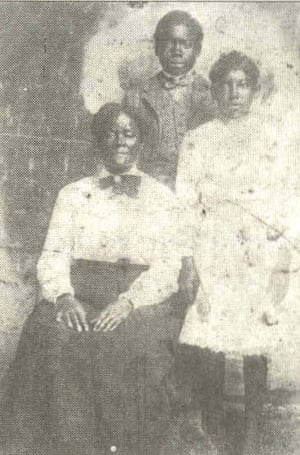
Sarah Carrier, left, Sylvester, standing and
Willie Carrier, right. Photograph: Public Domain
Another Rosewood resident, James Carrier, was shot
over the fresh graves of his brother and mother after several men
captured and interrogated him. He was first told to dig his own
grave, but couldn’t because two strokes had paralyzed one arm. The
men left his body splayed over the graves of his family members.
But despite widespread coverage of the incident –
the governor was even notified via telegram – the state did
nothing.
Not for one month, when it appears a feeble
attempt to indict locals was made by a grand jury, after all the
residents of Rosewood had long fled into the nearby swamps and
settlements of central Florida.
The oral history of Rosewood was a secret, passed
through several families with each recipient sworn to silence, as
black Americans endured decades of terror in Florida. When Jenkins
was six her parents would have had fresh memories of lynchings.
From 1877 to 1950, the county where the Robinsons
lived, Alachua, had among the largest sheer volume of lynchings of
any community in the nation, according to the Equal Justice
Initiative. Per capita, Florida lynched more people than any other
state. And counties surrounding Alachua were not friendlier.
Hernando, Citrus, Lafayette and Taylor counties
had some of the highest per capita rates of lynchings in the country.
By volume, nearby Marion and Polk counties had among the most in the
US. Legislation, reparations and state reckons with ugly past
The story only came to light in 1982, after a
reporter at the then St Petersburg Times exposed the forgotten riot.
The reporter, Gary Moore, had traveled to Cedar Key, 10 miles
south-west of Rosewood on the coast, to explore a Sunday feature on
the rural Gulf town.
“Like the public at large, I personally had
never heard of Rosewood,” Moore wrote in a synopsis of research
published in the 1993 report that was submitted to the Florida Board
of Regents. “I held dim assumptions that any such incident would
long ago have been thoroughly researched and publicized by
historians, sociologists, anthropologists, advocacy organizations, or
others.”
A crowd of white citizens of Sumner, near the
scene, are shown in 1923. Photograph: Bettmann/Corbis
That it wasn’t, Moore blamed on “psychological
denial” and “blindness”.
“There were many things thought better left
unquestioned,” Moore reasoned.
By 1993, before the report was issued, Moore’s
story had made a wide impact, becoming a 60 Minutes documentary and
earning follow-ups by other news outlets. Moore, however, recounted
in detail his struggle for academic and political acceptance of the
narrative, and said even 11 years after his story appeared many
attempted to deny the massacre occurred.
One of Moore’s sources, Arnett Doctor, would
later devote much of his life to lobbying for Rosewood reparations.
Doctor, a descendant of survivors, spent untold hours eliciting
detailed narratives of the event from survivors. He is often cited as
the “driving
force” behind the reparations bill, as the man who brought his
findings to high-powered attorneys at Holland & Knight, who
helped lobby the legislature for reparations.
Doctor died at the age of 72 in March 2015, in
Spring Hill, Florida, a few hours south of Rosewood.
“We deliberately avoided anything but
compensation for the losses they incurred,” said Martha Barnett, an
attorney at Holland & Knight who helped lobby the Florida
legislature on behalf of the survivors of Rosewood. Barnett said the
term “reparations” can’t be found in the law passed in Florida.
Instead, attorneys focused on private property
rights. She said she and other attorneys needed “to make it
something legislators could find palatable in the deep south some
20-some years ago”.
Barnett said the then Democratic governor, Lawton
Chiles, promised his support from the beginning. By April 1994, the
House
passed a bill to compensate victims of the attack with a 71-40
vote. Four days later, on 9 April 1994, the Senate
passed a matching bill with a vote of 26-14, to cries of “Praise
the lord!” from those Rosewood descendants present.
Rosewood was 37 miles south-east of Archer on the
main road to the Gulf. Photograph: Jessica Glenza
“It’s time for us to send an example, a
shining example, that we’re going to do what’s right – for
once,” Democratic senator Matthew Meadows said at the time. Chiles
died less
than four years after signing the bill.
Now, near Rosewood, Rebel flags are common.
Businesses bear the name, and some locals would be as happy to again
forget the incident.
Information on the pogrom is notably muted in some
local historical societies.
“What it takes to make someone whole, what it
takes to repair the past, is probably different for every person, and
some things are more effective than others,” said Barnett.
Many of the survivors invested the money they
received into their homes. Willie Evans, 87 when he received the
$150,000 payment in 1995, put a new
roof, windows and doors on his home. Mortin considered traveling
to Greece. Jenkins’s mother, who received $3,333.33 from the fund,
placed ledgers on the graves of her sister, three brothers and
parents.
“The thing that mattered most to [survivors] was
that the state of Florida said, ‘We had an obligation to you as our
citizens, we failed to live up to it then, we are going to live up to
it today, and we are sorry,’” Barnett said.
For Doctor, whose own identity seemed wrapped up
in the Rosewood story (the license plate on his truck read
“ROSEWOOD”),
even the unique success of the legislation was not enough. He dreamed
of rebuilding the town.
“The last leg of the [healing process] is the
redevelopment and revitalization of a township called Rosewood,”
Doctor told the Tampa
Bay Times in 2004, as the plaque along State Road 24 was
dedicated by then governor Jeb Bush. “If we could get $2bn, $3bn of
that we could effect some major changes in Levy County.”

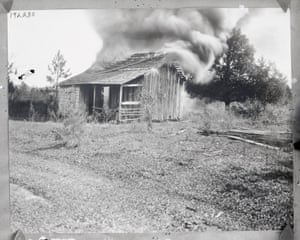
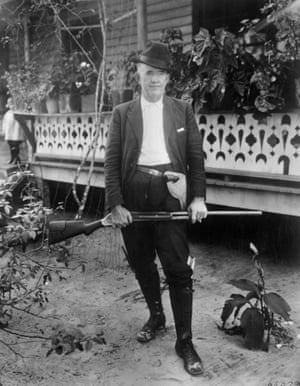
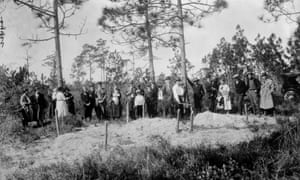

No comments:
Post a Comment